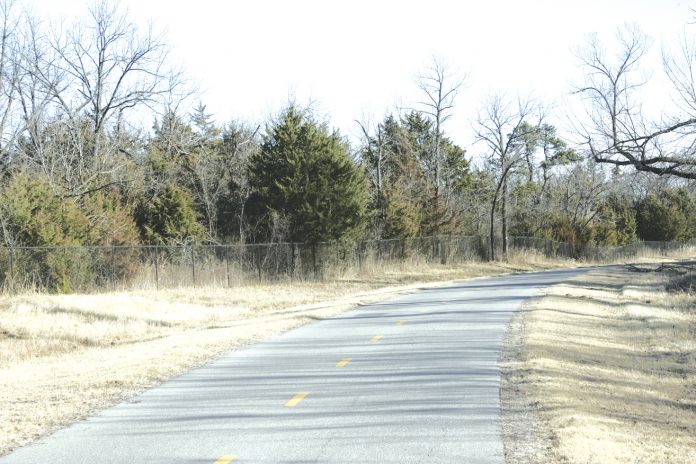Story and photos by Darl DeVault, Contributing Editor
Oklahoma City and the state offer many options for seniors trying to make a decisive quality of life New Year’s resolution to get outside more to walk and hike. Hiking can grow to be an extension of taking a nice walk as close as your front door to stroll in your neighborhood, popular local walking trails, and Oklahoma’s many lakes and state park trails.
Hiking does not have to start as physically demanding and challenging. It can simply be an adventure full of pleasant experiences to spend quality time with nature offering a sense of personal achievement.
Although the multi-use, 9.4-mile loop trail around northwest Oklahoma City’s Lake Hefner claims the most popular trail system in the metro, another newer trail is catching up. Completed in 2015, the West River Trail (WRT) follows the North Canadian River’s north bank from N.W. 10th Street to Meridian Avenue. It is protected from Oklahoma’s strong south winds in spring and summer and winter’s cold north winds along the wooded riverside. (story continues below)

Its 7.5-miles run from N.W. 10th Street west of Council Road to S.W. 15th Street at Meridian Avenue. It picks up from the Overholser Trail to connect to the east to the Oklahoma River Trails, allowing hikers access to and from the Boathouse District and downtown Oklahoma City.
The WRT is one of the three new trails created by tax dollars from MAPS 3. The other two trails are the Will Rogers Trail and the hilly and woodsy Lake Draper Trail circling the lake.
The WRT is a close-in rural trek that takes users along the North Canadian River and around Crystal Lake, away from streets and traffic. The trailheads offer parking at N.W. 10th Street on the west end or Reno Avenue or Crystal Lake midway through the wooded, scenic trail.
It is a part of the more than 90 miles of Oklahoma City’s multi-use trails. The trails system offers recreation and exercise and a network of 10 interconnected trails that can take users to almost every point in the city.
The multi-skill level WRT offers several activity options and is accessible year-round. Dogs are welcome but are required to be kept on a leash. No motorized vehicles are allowed on the trail system. This child-friendly trail is ideal for family nature trips with newly installed water fountains along the way. Many residents walk and run the course while taking in the many river views.
It is a venue of unexpected ruggedness. It offers close-in, tree-lined boundaries in some sections. Parts of the trail fit the description of a nature trail. Most of the other city trails are open and windswept.
Again, the metro’s most popular place to walk is still Lake Hefner. The lake sits between Hefner Road on the north and North Grand Boulevard on the south and just to the west of the busy Hefner Parkway. The walkers, runners, bikers, and in-line skaters make for heavy traffic on nice days, particularly on the east side of the lake and around Stars and Stripes Park on the south shore.
“It’s crowded sometimes but still a great place to walk or ride a bike,” says city resident Rita Hejny, who lives in the Edgewater neighborhood south of Stars and Stripes Park. “It adds so much scenery and space to the area.”
In addition to the trail activities, Lake Hefner offers restaurants and a venue for many other outdoor activities, including sailing, golf, and windsurfing. These sports provide visual entertainment to those wending their way around the trail at Oklahoma City’s mecca for outdoor sports.
Other metro urban trails include Bluff Creek, just north of Lake Hefner; Dolese Park in west Oklahoma City near Putnam City High School; and Lake Overholser in far west Oklahoma City, just south of the old Route 66 bridge on N.W. 39th Street. All offer a quick fix for exercisers needing a workout.
The more adventurous can find challenging nature trails throughout the state, anywhere from 45 minutes to 6 hours from Oklahoma City by car. The Wichita Mountains Wildlife Refuge, some 100 miles to the southwest off I-44, welcomes hikers to a rugged landscape filled with cactus plants and bison. It is the largest bison refuge managed by the U.S. Fish and Wildlife Service. The pristine Charon’s Garden Wilderness Area offers stunning backcountry vistas, a sparkling waterfall, and a secluded lake to those who venture across the challenging granite boulder field.
Other hikes in the refuge include Dog Run Hollow and a short climb to the top of Elk Mountain, with both offering animal sightings and thick patches of blackjack oak. “I go down to the Wichitas at least once or twice a year for a hike or a bike ride,” says Oklahoma City resident Howard Lucero. “It’s really not far for such a great outdoor setting.”
True outdoor thrill seekers can make the six-hour trek via auto to the far end of Oklahoma’s Panhandle for the eight-mile roundtrip hike to the state’s highest point, 4,973-foot Black Mesa Summit. Once ascended, this peak provides a three-state panorama of buttes and mesas covered with cholla cacti, sagebrush, and other Western flora.
For those who need a guide to outdoor venues across the state, “Oklahoma Hiking Trails” is available. Written and illustrated with maps and photos by Oklahoma City residents Kent Frates and Larry Floyd, the book provides exact information on nearly 60 natural and urban trails. The book can be ordered online at: www.bestoklahomatrails.com.














